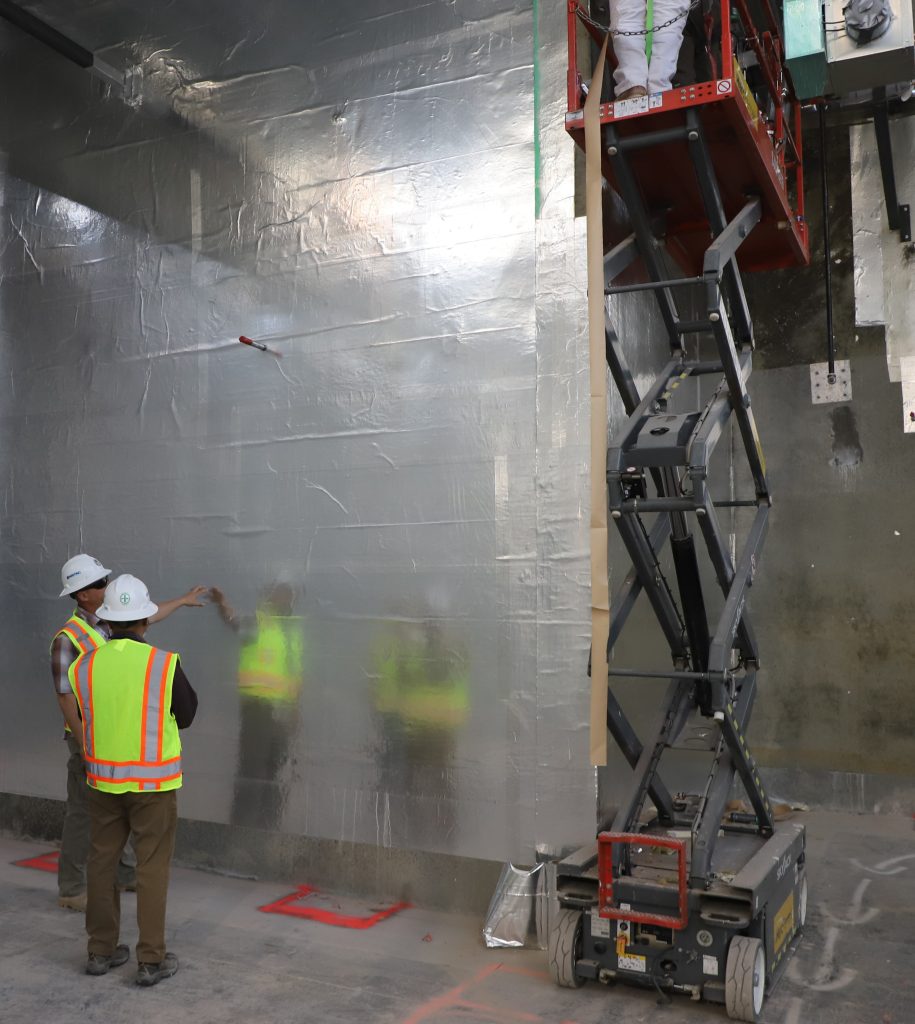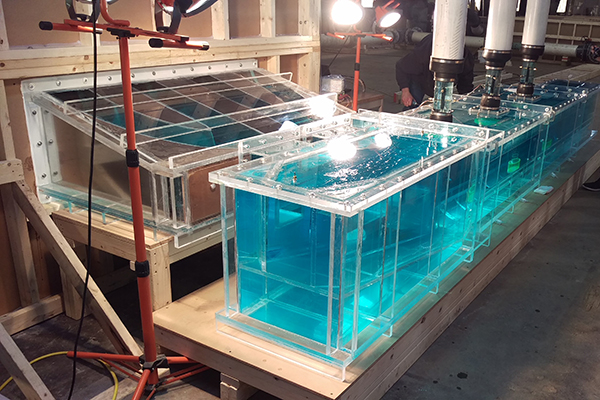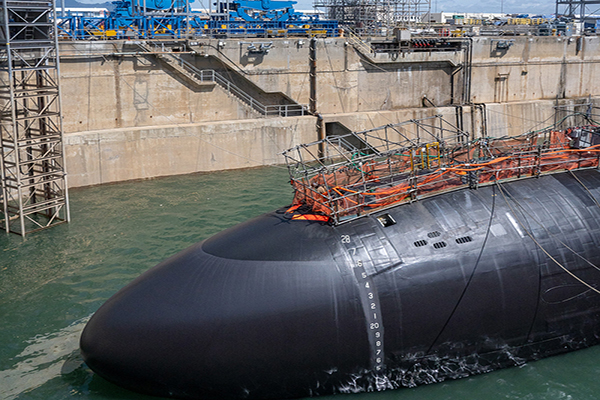By Lt. Cdr. Timothy Dahms, P.E., M.SAME, CEC, USN, and Edward Cartagena
As part of the earthquake recovery program at Naval Air Weapons Station China Lake, nearly 300,000-ft² of secure space must be constructed, requiring an integrated team of government owners, stakeholders, and industry members.
In July 2019, a pair of severe earthquakes severely affected Naval Air Weapons Station China Lake, Calif. Over the following six weeks, a team of experts from Naval Facilities Engineering Systems Command (NAVFAC) Southwest and Naval Air Warfare Center Weapons Division inspected infrastructure, facilities, and utilities. They identified over 1,300 structures that required an estimated $3.87 billion in repairs.
While ICD-705 construction is difficult in new construction, it is extraordinarily challenging in existing buildings. The approach taken, however, is the same.
In August 2020, NAVFAC established Officer In Charge of Construction (OICC) China Lake to administer a five-year, 27-project, $2.7-billion earthquake recovery program. The purpose-built integrated team, comprised of NAVFAC, Naval Air Systems Command, and industry contractors, strategically paired construction experts and end-users. Along with proving imperative to constructing state-of-the-art facilities, the integrated team model has been critical to the nearly 330,000-ft² of secure space now being constructed at China Lake.
Early Collaboration
As the foundational document for technical security design criteria for secure spaces within the federal government, Intelligence Community Directive 705 (ICD-705) is designed to ensure the protection of sensitive compartmented information. The document was developed jointly by the 17 agencies of the U.S. Intelligence Community, with updates released by the Office of the Director of National Intelligence.
As part of the recovery program at China Lake, a total of 14 separate contracts were administered that include the 330,000-ft² of ICD-705 secured space. A pair of those contracts comprise more than two-thirds of that real estate (the six-project South Airfield Complex includes 130,000-ft² of ICD-705 space; and the Dr. Marguerite “Peggy” Rogers – Mission Systems Integration Laboratory includes 105,000-ft² of ICD-705 space).
Early on in its establishment, OICC China Lake established a Community of Contractors Forum that brought together senior executives from each prime contractor. Through this effort, the team received feedback on site security management (SSM), and the Naval Air Warfare Center Weapons Division provided resources to include a site security director and multiple SSM team members to support construction security plans across all projects requiring ICD-705 spaces. This team of experts was critical to sharing lessons learned across projects from the beginning of design through construction and accreditation.
Another early collaborative effort between the prime contractor, ECC, and lead subcontractor, Hensel Phelps, saw the construction of a mock-up structure to demonstrate how ICD-705 requirements were going to be met. This model allowed their trade partners to practice construction to meet the highly particular performance-based specifications. Even before construction began on the mock-up, in fact, the contractor team hosted a mission brief with both trade and government partners to review how ICD-705 construction differed from other commercial and federal projects.
Security-Focused
Before any design of ICD-705 spaces or facilities can begin, an analysis of threats needs to be made to inform design decisions and determine the scope of physical and technical security requirements. These then dictate the space requirements as part of the planned footprint for the facility and all its support systems, equipment, personnel, and procedures.
Both Intelligence Community Specifications 705-1 and Intelligence Community Technical Specification include minimum and enhanced security requirements. The authorizing official and certified TEMPEST technical authority evaluate threats and account for TEMPEST features and security-in-depth to balance the security requirements with cost, along with implementing security enhancements above the minimum to reduce risk to an acceptable level.
Security requirements for ICD-705 spaces increase the costs well above conventional construction. Designers must prioritize countermeasures that address risk, but do not exceed the authorizing official-approved recommendations. The design team must partner with the government to determine minimum and enhanced security requirements. After contract award, planning requirements are validated with the authorizing official and certified TEMPEST technical authority as soon as possible.

Before construction, the authorizing official must approve the final design. Throughout design approval, the parties agree upon the interpretation of the Intelligence Community Technical Specifications. As a best practice, the designer can provide a separate security-focused design package that includes only those design documents with details of penetrations through secure perimeters. Further developing narratives, details, product data sheets, and test reports can also expedite design approval. Finally, mock-ups greatly help in approving certain design details.
Secure Onsite
Site security starts at requirements development. Conducting a site-specific threat analysis is first and foremost. What works at one site may not work for the next. The more security enhancements a facility has, the more difficult it may be to maintain. Designing to site-specific threats enables more flexible design work and reduces costs over the life of a facility.
A key lesson is having a single point of contact with the accrediting official. For OICC China Lake, this was the site security director. Having a single point of contact ensured that the understanding of terms, conditions, and specifications was the same, regardless of project. This individual could also solve conflicts by consolidating questions and feedback to compare how different contractors were resolving similar issues, preventing misunderstandings and misinterpretations from the site security team.
Careful Construction
Successful construction of secure spaces relies heavily on an understanding of ICD-705 construction; implementation of both traditional and innovative construction methods; and early buy-in from the trades involved. To this end, at China Lake, a series of on-site meetings and trainings were held for all trade partners. An introductory meeting explained why ICD-705 accreditation is important to the mission. Basic training was conducted to review project scope and the “dos and don’ts” for ICD-705 construction. Lastly, a preparatory meeting was held to review every detail.
Selecting the right materials is as important as the construction on secure facilities. For example, radio frequency (RF) shielding is required to prevent RF transmission into or out of ICD-705 spaces. Achieving this is delicate work with limited manufacturers in the U.S. market. rFoil is a heavy duty radiant barrier sheet made up of a single layer of woven polyethylene material bonded to and sandwiched between two highly reflective aluminum surfaces. To ensure uninterrupted shielding, conductive adhesive foil tape is also required at seams in the rFoil. This tape costs over $500/100-ft roll, so buying and using the wrong tape is an expensive mistake.
Preventing gaps in the shielding is difficult when it comes to access points and doors. Pre-manufactured RF rated doors are highly recommended, as it is very difficult to achieve the same level of workmanship under field conditions.
Unexpected issues and unforeseen conditions can be expected during construction. Security walks by the authorizing official or security team can lead to identification of new issues or threats and suggestions or concerns. These need to be addressed with the construction team, end-users, and the security team to collaborate and find a solution. After walking the site, discussing details, and agreeing on a path forward, documenting the solution in a request for information will incorporate the change contractually.
The Right Team
Building an SSM team can be a challenge. The team must be physically on-site daily and work in unison with the project delivery team. They must also be supported by requirements leads and supervisory general engineers.
The SSM team’s primary focus for most of the project will be documentation. Any security features of work in construction must be recorded in both written and photographic evidence. Any use of electronic devices must be documented as well. OICC China Lake utilized a wiki repository for thousands of photos that were geo-tagged to the exact location of the work being documented. Finally, this team must work closely with the contractor to ensure means and methods align with the design.
While ICD-705 construction is difficult in new construction, it is extraordinarily challenging in existing buildings. The approach taken, however, is the same. With an established site security team, lessons learned can be applied in real time across multiple contracts. Construction methods are modified for renovation projects, taking into account existing conditions (but RF shielding requirements for penetrations/basements and structural elements do not change).
Improving Delivery
There are a number of best practices for designing and constructing ICD-705 spaces. An integrated team, a robust security design package, building mock-ups, and early SSM and authorizing official involvement can all produce a successful ICD-705 project. Not having even one of these can be detrimental to success.
These critical lessons learned from such a large concentration of new ICD-705 space construction at China Lake has garnered attention from multiple service branches and agencies to further improve delivery of this type of construction due to ever-evolving threats. The collaborative government and contractor teams on this expansive program also have shared these design and construction best practices through industry-government engagement opportunities.
Lt. Cdr. Timothy Dahms, P.E., M.SAME, CEC, USN, is Operations Officer
Edward Cartagena is Public Affairs Officer, OICC China Lake, Calif.
They can be reached at timothy.r.dahms.mil@us.navy.mil; and artag.j.cartagena.civ@us.navy.mil.
More News from TME
-

Setting Standards For the Future at Norfolk Naval Shipyard
The renovation for Dry Dock 4 at Norfolk Naval Shipyard, utilized advanced 3D and scale modeling to guide the design choices that would prepare the facility for another 50 years of service while meeting increased standards for resiliency and redundancy. -

Improving NAVFAC’s Facilities Construction Community
Naval Facilities Engineering Systems Command has implemented a series of process improvements across its construction workforce to increase recruitment, validate and standardize mastery of processes and procedures, and recognize accomplishments of personnel. -

Modernizing Dry Dock No. 1 at Naval Base San Diego
A recent project to modernize Dry Dock No. 1 at Naval Base San Diego will allow the facility to service modern vessel types while increasing its reliability for decades.